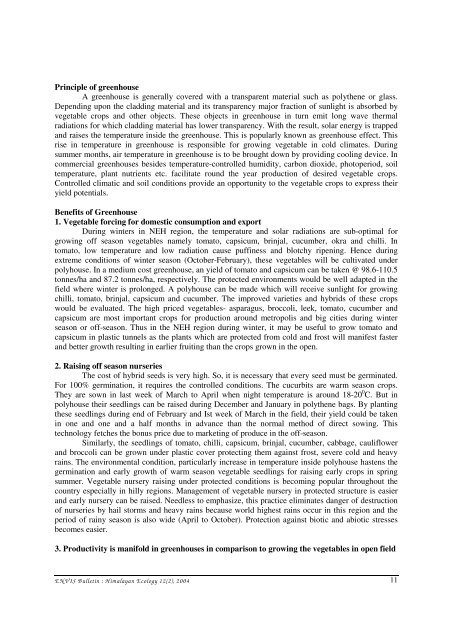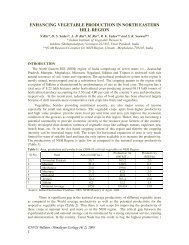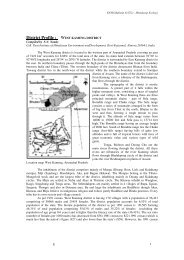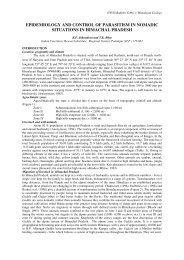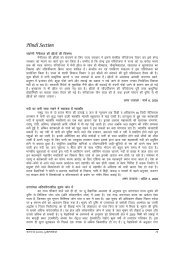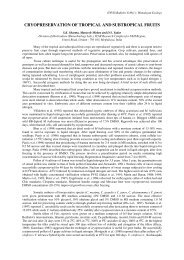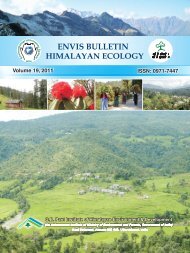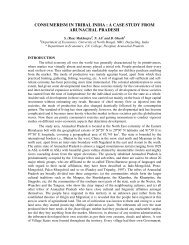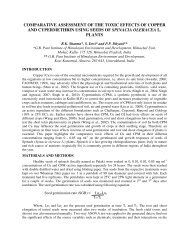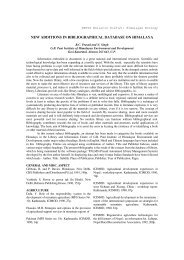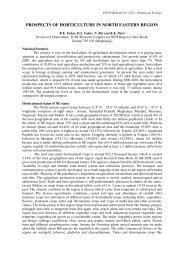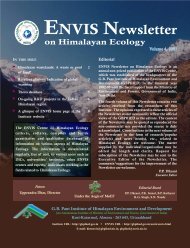ENVIS BULLETIN - ENVIS Centre on Himalayan Ecology
ENVIS BULLETIN - ENVIS Centre on Himalayan Ecology
ENVIS BULLETIN - ENVIS Centre on Himalayan Ecology
You also want an ePaper? Increase the reach of your titles
YUMPU automatically turns print PDFs into web optimized ePapers that Google loves.
Principle of greenhouseA greenhouse is generally covered with a transparent material such as polythene or glass.Depending up<strong>on</strong> the cladding material and its transparency major fracti<strong>on</strong> of sunlight is absorbed byvegetable crops and other objects. These objects in greenhouse in turn emit l<strong>on</strong>g wave thermalradiati<strong>on</strong>s for which cladding material has lower transparency. With the result, solar energy is trappedand raises the temperature inside the greenhouse. This is popularly known as greenhouse effect. Thisrise in temperature in greenhouse is resp<strong>on</strong>sible for growing vegetable in cold climates. Duringsummer m<strong>on</strong>ths, air temperature in greenhouse is to be brought down by providing cooling device. Incommercial greenhouses besides temperature-c<strong>on</strong>trolled humidity, carb<strong>on</strong> dioxide, photoperiod, soiltemperature, plant nutrients etc. facilitate round the year producti<strong>on</strong> of desired vegetable crops.C<strong>on</strong>trolled climatic and soil c<strong>on</strong>diti<strong>on</strong>s provide an opportunity to the vegetable crops to express theiryield potentials.Benefits of Greenhouse1. Vegetable forcing for domestic c<strong>on</strong>sumpti<strong>on</strong> and exportDuring winters in NEH regi<strong>on</strong>, the temperature and solar radiati<strong>on</strong>s are sub-optimal forgrowing off seas<strong>on</strong> vegetables namely tomato, capsicum, brinjal, cucumber, okra and chilli. Intomato, low temperature and low radiati<strong>on</strong> cause puffiness and blotchy ripening. Hence duringextreme c<strong>on</strong>diti<strong>on</strong>s of winter seas<strong>on</strong> (October-February), these vegetables will be cultivated underpolyhouse. In a medium cost greenhouse, an yield of tomato and capsicum can be taken @ 98.6-110.5t<strong>on</strong>nes/ha and 87.2 t<strong>on</strong>nes/ha, respectively. The protected envir<strong>on</strong>ments would be well adapted in thefield where winter is prol<strong>on</strong>ged. A polyhouse can be made which will receive sunlight for growingchilli, tomato, brinjal, capsicum and cucumber. The improved varieties and hybrids of these cropswould be evaluated. The high priced vegetables- asparagus, broccoli, leek, tomato, cucumber andcapsicum are most important crops for producti<strong>on</strong> around metropolis and big cities during winterseas<strong>on</strong> or off-seas<strong>on</strong>. Thus in the NEH regi<strong>on</strong> during winter, it may be useful to grow tomato andcapsicum in plastic tunnels as the plants which are protected from cold and frost will manifest fasterand better growth resulting in earlier fruiting than the crops grown in the open.2. Raising off seas<strong>on</strong> nurseriesThe cost of hybrid seeds is very high. So, it is necessary that every seed must be germinated.For 100% germinati<strong>on</strong>, it requires the c<strong>on</strong>trolled c<strong>on</strong>diti<strong>on</strong>s. The cucurbits are warm seas<strong>on</strong> crops.They are sown in last week of March to April when night temperature is around 18-20 0 C. But inpolyhouse their seedlings can be raised during December and January in polythene bags. By plantingthese seedlings during end of February and Ist week of March in the field, their yield could be takenin <strong>on</strong>e and <strong>on</strong>e and a half m<strong>on</strong>ths in advance than the normal method of direct sowing. Thistechnology fetches the b<strong>on</strong>us price due to marketing of produce in the off-seas<strong>on</strong>.Similarly, the seedlings of tomato, chilli, capsicum, brinjal, cucumber, cabbage, cauliflowerand broccoli can be grown under plastic cover protecting them against frost, severe cold and heavyrains. The envir<strong>on</strong>mental c<strong>on</strong>diti<strong>on</strong>, particularly increase in temperature inside polyhouse hastens thegerminati<strong>on</strong> and early growth of warm seas<strong>on</strong> vegetable seedlings for raising early crops in springsummer. Vegetable nursery raising under protected c<strong>on</strong>diti<strong>on</strong>s is becoming popular throughout thecountry especially in hilly regi<strong>on</strong>s. Management of vegetable nursery in protected structure is easierand early nursery can be raised. Needless to emphasize, this practice eliminates danger of destructi<strong>on</strong>of nurseries by hail storms and heavy rains because world highest rains occur in this regi<strong>on</strong> and theperiod of rainy seas<strong>on</strong> is also wide (April to October). Protecti<strong>on</strong> against biotic and abiotic stressesbecomes easier.3. Productivity is manifold in greenhouses in comparis<strong>on</strong> to growing the vegetables in open fieldE N V IS B ulletin : H im alayan E cology 12(2), 2004 11


